Continued from yesterday”¦ At 1345, when we pulled into the lock quay, we were told we were tying to a tug. We could see it up ahead, already tied up along the chamber wall in front of the gate. Its name is Atlas III and at the moment it was being used as a tourist tug that takes spectators up and down the Miraflores locks. Davidson told us that the tug is owned by the Canal Authority and is also used as an employee shuttle and to give orientation tours to the employees and their families.
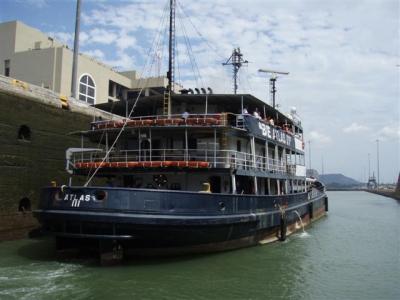
We didn’t get handed any lines. Instead, we pulled forward, lined ourselves up to the tug and tied up. The tie up was a little bit tricky. We had to readjust all our fenders to line up better with their fenders. We realized there was a vulnerable spot that couldn’t be properly fendered, so Eric had to move Kosmos a little bit so that our alignment against the tug changed in a way that the fenders would sit better. Here we all are frantically adjusting lines.
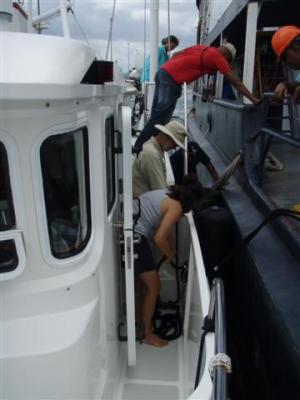
After a little more minor fender adjusting, we finally felt comfortable that we were adequately protected and gave the all clear to Davidson. The tourists on board gawked at us as we were getting situated. Also, here there is a big viewing gallery on shore for tourists to watch the canal process, and they were all staring at us, too. We started going down within seconds of Davidson passing the message on to the control tower. Century Pacific was again behind us in the chamber.
We were fully lowered and the gates were opening at 1355. We untied from the tug and backed up. Atlas III moved forward first, and we followed a few minutes later. At 1410, we pulled into the second chamber, approaching Atlas III to tie up. They were still tying up to the wall. Just as we were about to pull next to the tug, a huge 20 knot gust of wind came that blew the tug towards the opposite canal wall. Eric had to maneuver quickly to avoid hitting Atlas III in front of us, while still being wary of the canal wall to our immediate right. He gunned the engine full force in order to move fast enough for the delicate positioning needed. Susan was watching the wall, letting Eric know how much space he had to work with. Her eyes were like saucers as she watched us come within two feet of hitting the wall. Thankfully, at this point Eric is something of a pro at handling Kosmos, and despite the wind trying to push us away from Atlas II, he made a smooth approach at just the right spot along its side and we quickly tied to it. Century Pacific followed behind us, and within a couple minutes we were moving down again. Eric commented that the wind, which no one warned us about, is a much bigger stress than the turbulence, which several people had warned us about.
At 1420, we were at the bottom and the gates opened into the channel that leads into the Pacific Ocean. Wow! We did it! We successfully transited the canal and are back in the Pacific! We untied from Atlas II and this time we left the lock first. Congratulations to us!
We moved forward in the channel a little way until we came to an island with a small ship grounded on it. Davidson told us to stop near the island and wait for the pilot boat that would pick him up. The area immediately around us was a gritty looking container port, but in the background we could see a more upscale part of Panama City, with lots of high rises along the shoreline. The second photo is of the channel leading to the ocean and the Bridge of the Americas above it. The Bridge of the Americas was opened in 1962 and, until the Centennial Bridge opened in 2004, was the only major highway bridge that connected North and South Americas (the bridge we mentioned in Colon is considered a “service bridge”, not a “highway bridge” since it can’t be used all the time).
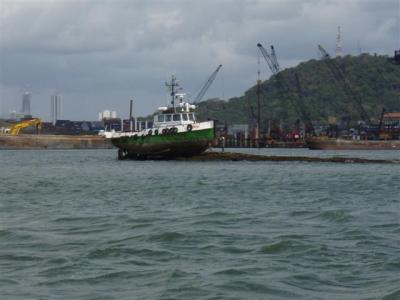
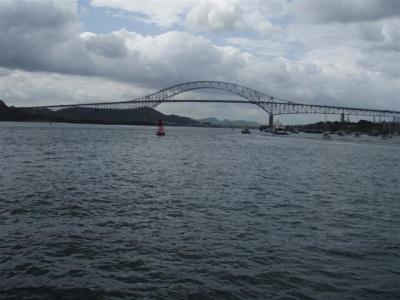
His pilot boat came only a few minutes later, but in that time we sat and debriefed. Eric commented that it was stressful to be in such a narrow lane of the locks. He needed to be keenly aware of everything going on, ready to veer or bow thrust the moment Kosmos yawed or was pushed by the wind, and he did do a lot of small shifting around. He said the center lock position was better for him, because he had more room to maneuver and the line handlers were doing most of the work in keeping the boat properly aligned. The side tie position was definitely more stressful for him. Even when we were already tied up to Atlas, he still had to do some bow thrustering to keep the tension off the lines.
When the pilot boat came, we all wished Davidson a big farewell. Here is a parting shot.
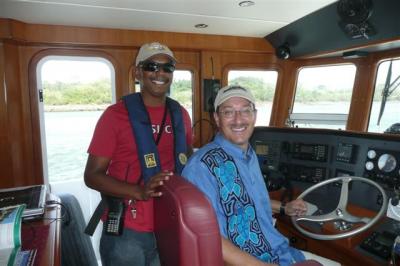
At this point, we still weren’t sure how we were going to get the crew off the boat. We decided to try to unload them at the fuel dock near Balboa Yacht Club, just off the channel. The yacht club facilities include moorings, but dingies are prohibited in the mooring area. To get to and from shore, the yacht club offers a shuttle service. The shuttle service is only for the people staying on the yacht club moorings. We saw their shuttle boat and flagged it down. They seemed to be more than happy to shuttle Tom, Susan, Edgar and Joel to shore in exchange for a few dollars. The shuttle pulled up to us and instantly the four of them were gone! And just as instantly, Christi’s tummy illness returned.
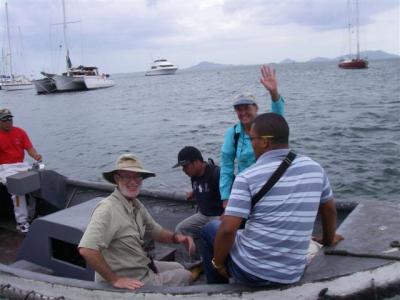
Jeff did another engine room check and found the shaft packing was back to a normal temperature and the fan was still working. That confirmed that maybe the fresh water somehow affected the shaft packing.
With only Jeff, Christi and Eric left, we moved towards the La Playita anchorage, tucked behind some small islands that dot Panama Bay. The US military once controlled these islands and they were heavily fortified for canal defense. The Americans built a causeway that connects the islands to one another and to the mainland, and there was a US military base where the causeway connects to the mainland. The causeway adds another layer of shelter to the anchorage.
As we approached the anchorage, on the radio we heard animated chatter about oil cans floating away and an unmanned boat dragging anchor. 100 yards ahead of us, we saw a dinghy retrieving oil cans and several more dinghies rushing to a sailboat that was on the outskirts of the anchorage. We focused our attention on the sailboat and watched as several people quickly tied up and boarded, then started letting out chain. We station kept nearby in case we needed to tow them in. It is so great how the boating community takes care of their own. Dinghies kept arriving, and by the time all clear was called, at least 6 dingies and 10 people were there, if not more.
Once we got the all clear, we found a spot and dropped anchor. It was windy as all get out, with big, choppy waves. Except for the few boats literally only a few feet from the causeway, all the boats in the anchorage were rolling like crazy. Eric is always careful to make sure that the anchor is set well, but this time he was extra careful. He dropped 250 feet chain in the 30-40 feet of water to help that ensure that we didn’t drag, too. The wind was screaming. It was 1600.
Eric and Jeff put the paravanes out while Christi stowed the lines and fenders. The three of us all got the dinghy down. Getting the dinghy down in strong wind is a challenge, and having the third set of hands to help keep the dinghy under control helped immensely. It was now 1700 and we were planning to head to shore soon for a celebratory meal. Once the dinghy was down, we noticed that we had drifted next to a boat that had originally been well behind us when we dropped anchor. Our paravanes were alarmingly close to them. Eric ran forward and pulled in about 50 feet of chain to position us in front of them again.
We were shocked. We thought there was no way on earth we could get close to this particular boat given the wind direction. That was when we noticed something bizarre. At anchor, Kosmos turns to face the wind. But not right now. At the moment, Kosmos’ port side was to the wind. We have a crazy strong tide and/or current to have enough force to keep us from following the wind. On further inspection, we noticed something even weirder. The boats closer in to shore were facing into the wind, but there was an actual line where the boats shifted direction. So, half the boats in the anchorage faced one way, the other half faced another.
It was clear we couldn’t go to shore. Chances were we would be switching directions multiple times here as the wind/tide/current fluctuated. We couldn’t count on the boats in the anchorage following the normal patterns, so for safety’s sake, we should be on board to make sure we didn’t get too close to anyone. None of us really minded skipping the celebratory dinner. The conditions were terrible in the bay, and getting back to Kosmos in the choppy seas after dark would not have been fun. Plus, we were all absolutely exhausted and weren’t up for a big night out. We wound up going to bed at 1930, with the anchor alarm set very close.
